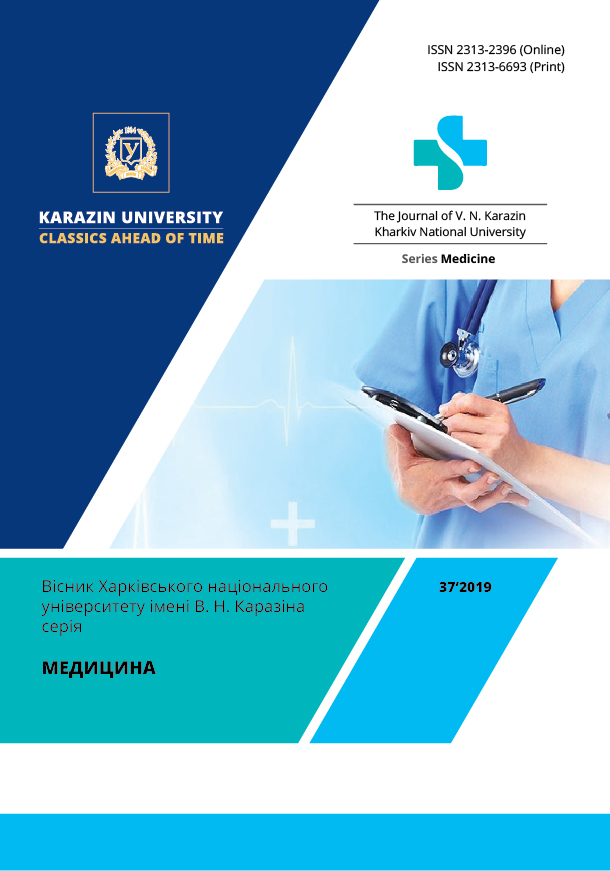Pulmonary embolism in young age
Abstract
Introduction. One of the risk factors for pulmonary embolism is age > 40 years. Lately, more and more cases of thromboembolism occur at a young age, that requires special attention in diagnosis and treatment. Objectives. The purpose of this article was to analyze the clinical case of thromboembolism at a young age. Material and methods. Our patient B., 33- year-old male was urgently hospitalized with the chest pain when breathing in, shortness of breath, blood-streaked sputum cough and body temperature up to 37-38.5 °С. 17.12.18 the bone immobilization of the right fibula due to a fracture was performed. 30.12.18 - the patient felt compressive pain in the right side of the chest, shortness of breath, blood-streaked sputum cough. An ambulance was called, but the patient was not hospitalized. Since 31.12.2018 till 05.01.2019 – body temperature rose to 38°C. 06.01.19 - a recurrence of initial symptoms. 07.01.19 - the chest pain intensified, patient was transported by ambulance to a hospital. During the examination: vesicular breathing, weakened in the lower sections, mostly on the right, respiratory rate -20/min, heart rate 100 beats/min, blood pressure 120/70 mm Hg. The main diagnosis: thromboembolism of the lobar arteries of the right lung. Class I, very low risk (43 points by PESI scale – Pulmonary Embolism Severity Index, 5 points by the Padua prediction score). Complication: right-sided inferior infarction-pneumonia. Concomitant diagnosis: fracture of the right fibula. Recommended treatment: rivaroxaban 12 mg; eplerenone 50 mg, ceftriaxone 1 g bid intravenous injection (IV), levofloxacin 500 mg IV, oxygen therapy. Results. Laboratory and instrumental studies were carried out. Laboratory tests revealed an increased in leukocytes, erythrocyte sedimentation rate, ALT, troponin І. ECG: right axis deviation. Computed tomography (CT) of the chest: CT signs of thromboembolism of the arteries of the right lung, right-sided inferior infarction-pneumonia, changes are more typical for an inflammatory process in the initial stage. Ultrasound examination of the abdominal organs and kidneys: diffuse changes of the liver parenchyma, traces of fluid in the right pleural cavity. Conclusions. Prolonged immobilization in young patients can be only one risk factor for the formation of pulmonary embolism. In order to predict possible complications in patients with pulmonary thromboembolism, it is necessary to take into account the initial state of the patient and associated diseases in each case.
Downloads
References
Parhomenko O.M. Tromboemboliya legenevoyi arteriyi / Lutaj Ya.M. // Nastanova z kardiologiyi, za red. V.M. Kovalenka. K.: MORION, 2009. S. 818856. [in Ukrainian].
Fesenko O.V. Analiz letalnyh ishodov pri tromboembolii legochnoj arterii u lic molodogo vozrasta / Sinopalnikov A.I., Glechikov A. V. // Terapevticheskij arhiv (arhiv do 2018 g.). – 2013. № 85 (3) – S. 4450. [in Russian].
Hosna S.A. Acute Pulmonary Embolism in a Young Patient with Deep Vein Thrombosis / Chaudhary M, Haque M.A. // International Journal of Radiology and Radiation Therapy. 2017. V.4, № 6. P. 13.
Chenaghlou M. Risk Factors and Prevention of Pulmonary Embolism in Young Adults / M. Chenaghlou, R. Parizad, M. Asghari Jafarabadi. // Crescent Journal of Medical and Biological Sciences. – 2017. – № 1. P. 712.
Mongan J. Age and sexdependent trends in pulmonary embolism testing and derivation of a clinical decision rule for young patients / Kline J, Smith-Bindman R. // Emergency Medicine Journal. – 2015. – № 32 Р. 840845.
Yachnik A.I. Tromboemboliya legenevoyi arteriyi: varianti perebigu, gemodinamichni oznaki ta osoblivosti tromboutvorennya / Shnirkova O.V., Yachnik V.A., Studnikova V.V. // Ukrayinskij pulmonologichnij zhurnal. – 2016. – № 1. – S. 2328. [in Ukrainian].
Stavros V. Konstantinides. Management of Pulmonary Embolism / Stefano Barco, Mareike Lankeit, Guy Meyer // Journal of the American College of Cardiology. – 2016. – № 8. – P. 976990.
Rekomendaciyi Yevropejskogo tovaristva kardiologiv shodo vedennya paciyentiv z TELA (2014), chastina 1. // Serce i sudini. – 2014. № 4. – S. 714. (in Ukrainian) 9. Rekomendaciyi Yevropejskogo tovaristva kardiologiv shodo vedennya paciyentiv z TELA (2014), chastina 2. // Serce i sudini. – 2015. № 1. – S. 714. [in Ukrainian].
Sakuma M. Pulmonary embolism is an important cause of death in young adults / Nakamura M, Takahashi T // Circulation Journal. – 2007. – № 71. – P. 1765 – 1770.
Reshetnyak T.M. Antifosfolipidnyiy sindrom: diagnostika i klinicheskie proyavleniya (lektsiya). // Nauchno-prakticheskaya revmatologiya. – 2014. – № 52(1). – S. 56–71. [in Russian]
The Journal of V. N. Karazin Kharkiv National University, series Medicine has following copyright terms:
- Authors retain copyright and grant the journal right of first publication with the work simultaneously licensed under a Creative Commons Attribution License that allows others to share the work with an acknowledgement of the work’s authorship and initial publication in this journal.
- Authors are able to enter into separate, additional contractual arrangements for the non-exclusive distribution of the journal’s published version of the work, with an acknowledgement of its initial publication in this journal.
- Authors are permitted and encouraged to post their work online prior to and during the submission process, as it can lead to productive exchanges, as well as earlier and greater citation of published work.




